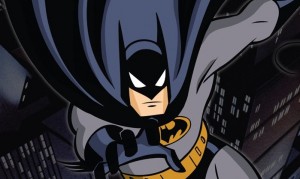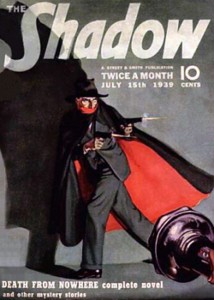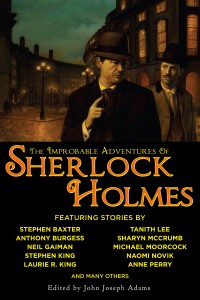Editorial: What’s Old Can Be New Again
 I once heard it said that the best way to fully appreciate the things you enjoy most is to learn what influenced those things. Then when you discover those influences, go back and discover what inspired those influences, and so forth. It might have been Jon Bon Jovi that said that, now that I think about it. Regardless, it’s an idea that has stuck with me over the years, and it’s a large part of why I’m constantly digging through the histories for quality genre classics. From Star Wars, I learned about Buck Rogers, Flash Gordon, and the old Republic serials. From Star Trek, I learned about Arthur C. Clarke, Isaac Asimov, Jules Verne, and H.G. Wells. The list goes on.
I once heard it said that the best way to fully appreciate the things you enjoy most is to learn what influenced those things. Then when you discover those influences, go back and discover what inspired those influences, and so forth. It might have been Jon Bon Jovi that said that, now that I think about it. Regardless, it’s an idea that has stuck with me over the years, and it’s a large part of why I’m constantly digging through the histories for quality genre classics. From Star Wars, I learned about Buck Rogers, Flash Gordon, and the old Republic serials. From Star Trek, I learned about Arthur C. Clarke, Isaac Asimov, Jules Verne, and H.G. Wells. The list goes on.
 I was a big fan of comics throughout the 80s and 90s, but somewhere around the turn of the millennium, I just got bored with them. The reason why was because by that point I had been introduced to the predecessor of the comic book: the pulp magazine. I rediscovered Batman in the late 80s, in the years leading up to Tim Burton’s ’89 movie that kickstarted “Batmanania†for the rest of the world. It’s quite possibly the only time in my life where I’ve been ahead of the curve in terms of pop culture. By the time Batman: The Animated Series debuted, I was diehard fan, and that series only strengthened that interest. That was also the year I left Smallville and entered college life at a Metropolis university.
I was a big fan of comics throughout the 80s and 90s, but somewhere around the turn of the millennium, I just got bored with them. The reason why was because by that point I had been introduced to the predecessor of the comic book: the pulp magazine. I rediscovered Batman in the late 80s, in the years leading up to Tim Burton’s ’89 movie that kickstarted “Batmanania†for the rest of the world. It’s quite possibly the only time in my life where I’ve been ahead of the curve in terms of pop culture. By the time Batman: The Animated Series debuted, I was diehard fan, and that series only strengthened that interest. That was also the year I left Smallville and entered college life at a Metropolis university.
 There’s nothing quite like the college experience to expand one’s horizons. It was there I met a friend of mine who became my supplier for all things relating to The Shadow. As I mentioned to Big Dog on the podcast, the 1939 radio episode “Horror in Wax†was the one I heard. From there, I was able to locate a few episodes on cassette here and there, but Conde Nast (the Shadow’s copyright holder) wasn’t too forthcoming with such things until about the time the ‘94 movie hit the big screen, and the internet as we know it didn’t exist yet. It’s enough to drive a fanboy nuts. I think the lack of access to the material, combined with the knowledge that it existed, only served to fuel the addiction and make each new acquisition that much more of a treasure. As the years went by, I managed to delve deeper and deeper into that rabbit hole, soaking up more radio episodes and pulp stories.
There’s nothing quite like the college experience to expand one’s horizons. It was there I met a friend of mine who became my supplier for all things relating to The Shadow. As I mentioned to Big Dog on the podcast, the 1939 radio episode “Horror in Wax†was the one I heard. From there, I was able to locate a few episodes on cassette here and there, but Conde Nast (the Shadow’s copyright holder) wasn’t too forthcoming with such things until about the time the ‘94 movie hit the big screen, and the internet as we know it didn’t exist yet. It’s enough to drive a fanboy nuts. I think the lack of access to the material, combined with the knowledge that it existed, only served to fuel the addiction and make each new acquisition that much more of a treasure. As the years went by, I managed to delve deeper and deeper into that rabbit hole, soaking up more radio episodes and pulp stories.
The point of this little backstory is to encourage the idea that newer doesn’t always mean better. For every genre, and especially for science fiction and fantasy, it’s always important to push forward, but it’s just as important to remember from whence it all comes. Sometimes what’s old can be new again. Hollywood has certainly figured that out with their never-ending reboot machine. They do it to play on nostalgia – you can’t buy the kind of marketing that comes from happy memories, but apparently you can rent it. To that end, however, the reboots rarely seem to be up to quality. I suppose it could be argued that ignorance is bliss; the less you know about what came before, the less you’ll be disappointed by the reboot. Maybe that’s true. I prefer, however, to honor the past. The characters and creators of yesteryear have a lot to offer modern audiences. More than that, the offerings of past and present will forever continue to inspire the future. The more we acknowledge it, the better quality the future material will be. The less Hollywood’s reboot machine will be able to get away with chop shop level quality. We all vote with our dollars, after all, and it’s the only lesson Hollywood will ever get. The same goes for television, books, radio, and whatever else comes down from the ether to inspire and delight us.
 Besides, you never know where those older influences will lead you next. For example, I’m going to take a moment to publicly praise long-time science fiction writer Robert J. Sawyer – just because I can. Thanks to our sponsor (Audible.com), I recently listened to a short story anthology, The Improbable Adventures of Sherlock Holmes, which collected Holmes stories from the past 30 years or so that forced the Great Detective to confront the very things in which he doesn’t believe.  Sawyer’s story “You See But You Do Not Observe†is the last tale in the anthology, directly following a Neil Gaiman story – that’s how you know it’s incredible: it had to follow Gaiman! It was written 19 years ago for a different anthology, but the strength of the story and the level of hardcore sci-fi was enough to make me track down the author’s website to let him know how much I enjoyed it. What creator doesn’t want to know their work is appreciated, right? Sawyer’s work is vastly different from anything I’ll ever read in the old pulps, but based on the other works I’ve read so far, he’s also consistently amazing. This is how doors to greatness are discovered… or rediscovered.
Besides, you never know where those older influences will lead you next. For example, I’m going to take a moment to publicly praise long-time science fiction writer Robert J. Sawyer – just because I can. Thanks to our sponsor (Audible.com), I recently listened to a short story anthology, The Improbable Adventures of Sherlock Holmes, which collected Holmes stories from the past 30 years or so that forced the Great Detective to confront the very things in which he doesn’t believe.  Sawyer’s story “You See But You Do Not Observe†is the last tale in the anthology, directly following a Neil Gaiman story – that’s how you know it’s incredible: it had to follow Gaiman! It was written 19 years ago for a different anthology, but the strength of the story and the level of hardcore sci-fi was enough to make me track down the author’s website to let him know how much I enjoyed it. What creator doesn’t want to know their work is appreciated, right? Sawyer’s work is vastly different from anything I’ll ever read in the old pulps, but based on the other works I’ve read so far, he’s also consistently amazing. This is how doors to greatness are discovered… or rediscovered.
So my message is simply this: don’t be afraid to discover. Just because something isn’t currently trending, it doesn’t mean there isn’t merit. Trends are set by word of mouth. In the modern age of social media, what’s old can legitimately be new again. That’s how the steampunk craze keeps going, after all, so there must be something to this idea.










The Gaiman story? Is that “A Study in Emerald?” That’s a great story! I like to go back and study what’s come before, also. I’ve got about 10 encyclopedias on sci-fi, fantasy, and horror encompassing all media. I love to thumb through these and find new favorite things to geek out over. And, of course, there is always my childhood. Hardy Boys Detective Mysteries, Tom Swift Boy Genius, my favorite Shogun Warriors toys, and bajillions of other movies and books! There really isn’t any reason for a geek to get bored.
That’s the one, “A Study in Emerald!” So true – it is a great story, but it’s Gaiman… how could it be otherwise?
Absolutely – there’s no reason for a geek to get bored. Wow… Hardy Boys and Tom Swift. That takes me back. I haven’t read those in years.